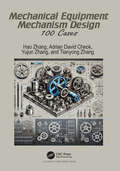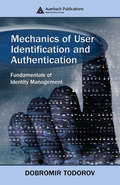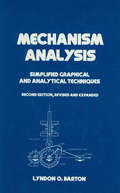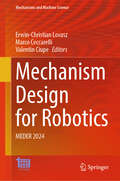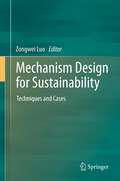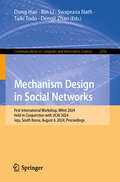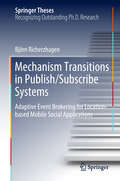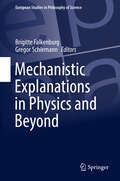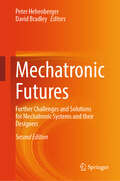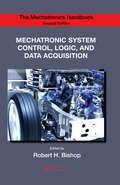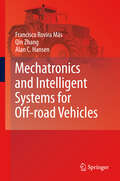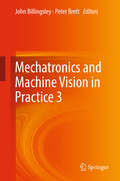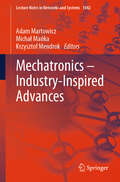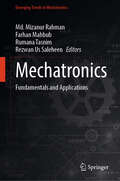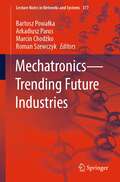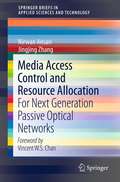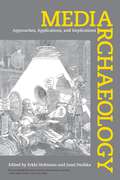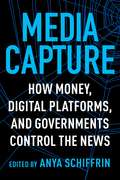- Table View
- List View
Mechanical Equipment Mechanism Design: 100 Cases
by Hao Zhang Adrian David Cheok Yujun Zhang Tianyong ZhangIn recent years, many new products have emerged in machinery and electronics, necessitating innovative designs. As a result, the mechanism designs of mechanical equipment are facing greater challenges. The mechanical mechanism is a crucial component of machines. An ideal mechanism design plays a pivotal role in the development of new products. Using their vast experience in technical designs, the authors have compiled a collection of 100 design cases in this volume. The volume aims at assisting technicians engaged in mechanism design and innovation in developing their own unique design concepts and becoming more proficient in the innovative design of mechanisms. The cases presented in this book are all drawn from practical production experiences, and each case study clearly outlines the details of the mechanism in question. While they may not be optimally designed, all achieve their intended functions.
Mechanics of User Identification and Authentication: Fundamentals of Identity Management
by Dobromir TodorovUser identification and authentication are absolutely essential to modern security. Mechanics of User Identification and Authentication presents the general philosophy of user authentication and access control. Introducing key concepts, this text outlines the process of controlled access to resources through authentication, authorization, and accounting. It provides specific information on the user authentication process for both UNIX and Windows. Addressing more advanced applications and services, the author presents common security models such as GSSAPI and discusses authentication architecture. Each method is presented with a specific authentication scenario.
Mechanism Analysis: Simplified and Graphical Techniques, Second Edition, (Mechanical Engineering)
by Lyndon O. BartonThis updated and enlarged Second Edition provides in-depth, progressive studies of kinematic mechanisms and offers novel, simplified methods of solving typical problems that arise in mechanisms synthesis and analysis - concentrating on the use of algebra and trigonometry and minimizing the need for calculus.;It continues to furnish complete coverag
Mechanism Design for Robotics: MEDER 2024 (Mechanisms and Machine Science #166)
by Erwin-Christian Lovasz Marco Ceccarelli Valentin CiupeThis book presents the proceedings of the 6th IFToMM Symposium on Mechanism Design for Robotics (MEDER), held in Timişoara, Romania, 27–29 June 2024. It gathers contributions by researchers from several countries on all major areas of robotic research, development and innovation, as well as new applications and current trends. The topics covered include: theoretical and computational kinematics, mechanism design, experimental mechanics, mechanics of robots, control issues of mechanical systems, machine intelligence, innovative mechanisms and applications, linkages and manipulators, micro-mechanisms, dynamics of machinery and multi-body systems. Given its scope, the book offers a source of information and inspiration for researchers seeking to improve their work and gather new ideas for future developments.
Mechanism Design for Sustainability
by Zongwei LuoThis book provides advanced analytics and decision management techniques and tools for developing sustainable competitive advantages in the studied target context. In order to achieve sustainable economy, "the capacity to endure," it is essential to understand and study the mechanisms for interactions and impact from and among these perspectives.
Mechanism Design in Social Networks: First International Workshop, MNet 2024, Held in Conjunction with IJCAI 2024, Jeju, South Korea, August 4, 2024, Proceedings (Communications in Computer and Information Science #2210)
by Bin Li Dengji Zhao Dong Hao Swaprava Nath Taiki TodoThis book constitutes the proceedings of the First International Workshop on Mechanism Design in Social Networks, MNet 2024, held in conjunction with IJCAI 2024, in Jeju, South Korea, on August 4, 2024. The 5 full and 3 short papers included in these proceedings were carefully reviewed and selected from 21 submissions. They focus on providing an internationally respected forum for scientific research tackling the fundamental challenges of mechanism design in social networks.
Mechanism Design: A Linear Programming Approach
by Rakesh V. VohraMechanism design is an analytical framework for thinking clearly and carefully about what exactly a given institution can achieve when the information necessary to make decisions is dispersed and privately held. This analysis provides an account of the underlying mathematics of mechanism design based on linear programming. Three advantages characterize the approach. The first is simplicity: arguments based on linear programming are both elementary and transparent. The second is unity: the machinery of linear programming provides a way to unify results from disparate areas of mechanism design. The third is reach: the technique offers the ability to solve problems that appear to be beyond solutions offered by traditional methods. No claim is made that the approach advocated should supplant traditional mathematical machinery. Rather, the approach represents an addition to the tools of the economic theorist who proposes to understand economic phenomena through the lens of mechanism design.
Mechanism Transitions in Publish/Subscribe Systems
by Björn RicherzhagenThis book reports on a novel concept of mechanism transitions for the design of highly scalable and adaptive publish/subscribe systems. First, it introduces relevant mechanisms for location-based filtering and locality-aware dissemination of events based on a thorough review of the state-of-the-art. This is followed by a detailed description of the design of a transition-enabled publish/subscribe system that enables seamless switching between mechanisms during runtime. Lastly, the proposed concepts are evaluated within the challenging context of location-based mobile applications. The book assesses in depth the performance and cost of transition execution, highlighting the impact of the proposed state transfer mechanism and the potential of coexisting transition-enabled mechanisms.
Mechanistic Explanations in Physics and Beyond (European Studies in Philosophy of Science #11)
by Brigitte Falkenburg Gregor SchiemannThis volume offers a broad, philosophical discussion on mechanical explanations. Coverage ranges from historical approaches and general questions to physics and higher-level sciences . The contributors also consider the topics of complexity, emergence, and reduction. Mechanistic explanations detail how certain properties of a whole stem from the causal activities of its parts. This kind of explanation is in particular employed in explanatory models of the behavior of complex systems. Often used in biology and neuroscience, mechanistic explanation models have been often overlooked in the philosophy of physics. The authors correct this surprising neglect. They trace these models back to their origins in physics. The papers present a comprehensive historical, methodological, and problem-oriented investigation. The contributors also investigate the conditions for using models of mechanistic explanations in physics. The last papers make the bridge from physics to economics, the theory of complex systems and computer science . This book will appeal to graduate students and researchers with an interest in the philosophy of science, scientific explanation, complex systems, models of explanation in physics higher level sciences, and causal mechanisms in science.
Mechanizing Hypothesis Formation: Principles and Case Studies
by Jan Rauch Milan Šimůnek David Chudán Petr MášaMechanizing hypothesis formation is an approach to exploratory data analysis. Its development started in the 1960s inspired by the question “can computers formulate and verify scientific hypotheses?”. The development resulted in a general theory of logic of discovery. It comprises theoretical calculi dealing with theoretical statements as well as observational calculi dealing with observational statements concerning finite results of observation. Both calculi are related through statistical hypotheses tests. A GUHA method is a tool of the logic of discovery. It uses a one-to-one relation between theoretical and observational statements to get all interesting theoretical statements. A GUHA procedure generates all interesting observational statements and verifies them in a given observational data. Output of the procedure consists of all observational statements true in the given data. Several GUHA procedures dealing with association rules, couples of association rules, action rules, histograms, couples of histograms, and patterns based on general contingency tables are involved in the LISp-Miner system developed at the Prague University of Economics and Business. Various results about observational calculi were achieved and applied together with the LISp-Miner system. The book covers a brief overview of logic of discovery. Many examples of applications of the GUHA procedures to solve real problems relevant to data mining and business intelligence are presented. An overview of recent research results relevant to dealing with domain knowledge in data mining and its automation is provided. Firsthand experiences with implementation of the GUHA method in the Python language are presented.
Mechatronic Futures: Further Challenges and Solutions for Mechatronic Systems and their Designers
by David Bradley Peter HehenbergerThis book, a new and revised edition of “Mechatronic Futures”, sets out to identify and discuss the key issues likely to impact on the design and implementation of future mechatronic systems. In doing so, it offers a comprehensive overview of the challenges, risks and options that define the future of mechatronics and provides insights into how these issues are currently being assessed and managed. The book aims to support mechatronics practitioners in identifying key areas in design, modelling and technology and to place these in the wider context of concepts such as cyber-physical systems, Digital Twins and the Internet of Things and alongside issues such as privacy, security and sustainability. For educators, it considers the potential effects of developments in these areas on mechatronic course design, and ways of integrating these. Written by experts in the field, it explores topics including systems integration, design, modelling, privacy, ethics, lifecycle monitoring, sustainability and other potential future application domains. This new edition contains many new chapters as well as updated and revised chapters from the previous edition, and takes into account how recent significant developments in artificial intelligence and cyber-security are changing how current mechatronic systems are designed, manufactured, operated, used and potentially recycled. Highlighting novel innovations and directions, the book is intended for academics, engineers, managers, researchers and students working in the field of mechatronics, particularly those developing new concepts, methods and ideas.
Mechatronic System Control, Logic, and Data Acquisition (The Mechatronics Handbook, Second Edition)
by Robert H. BishopThe first comprehensive and up-to-date reference on mechatronics, Robert Bishop's The Mechatronics Handbook was quickly embraced as the gold standard in the field. With updated coverage on all aspects of mechatronics, The Mechatronics Handbook, Second Edition is now available as a two-volume set. Each installment offers focused coverage of a particular area of mechatronics, supplying a convenient and flexible source of specific information. This seminal work is still the most exhaustive, state-of-the-art treatment of the field available.Focusing on the most rapidly changing areas of mechatronics, this book discusses signals and systems control, computers, logic systems, software, and data acquisition. It begins with coverage of the role of control and the role modeling in mechatronic design, setting the stage for the more fundamental discussions on signals and systems. The volume reflects the profound impact the development of not just the computer, but the microcomputer, embedded computers, and associated information technologies and software advances. The final sections explore issues surrounding computer software and data acquisition. Covers modern aspects of control design using optimization techniques from H2 theoryDiscusses the roles of adaptive and nonlinear control and neural networks and fuzzy systemsIncludes discussions of design optimization for mechatronic systems and real-time monitoring and controlFocuses on computer hardware and associated issues of logic, communication, networking, architecture, fault analysis, embedded computers, and programmable logic controllers
Mechatronics and Intelligent Systems for Off-road Vehicles
by Francisco Rovira Más Alan C. Hansen Qin ZhangRapid developments in electronics over the past two decades have induced a move from purely mechanical vehicles to mechatronics design. Recent advances in computing, sensors, and information technology are pushing mobile equipment design to incorporate higher levels of automation under the novel concept of intelligent vehicles. Mechatronics and Intelligent Systems for Off-road Vehicles introduces this concept, and provides an overview of recent applications and future approaches within this field. Several case studies present real examples of vehicles designed to navigate in off-road environments typically encountered by agriculture, forestry, and construction machines. The examples analyzed describe and illustrate key features for agricultural robotics, such as automatic steering, safeguarding, mapping, and precision agriculture applications. The eight chapters include numerous figures, each designed to improve the reader's comprehension of subjects such as: * automatic steering systems; * navigation systems; * vehicle architecture; * image processing and vision; and * three-dimensional perception and localization. Mechatronics and Intelligent Systems for Off-road Vehicles will be of great interest to professional engineers and researchers in vehicle automation, robotics, and the application of artificial intelligence to mobile equipment; as well as to graduate students of mechanical, electrical, and agricultural engineering.
Mechatronics and Machine Vision in Practice 3
by John Billingsley Peter BrettIn contrast with previous books on mechatronics and machine vision in practice, a significant number of chapters focus on systems designed for human interaction and deciphering human motion. Examples illustrate assistive actuation of hip joints, the augmentation of touch sense in artificial hand prostheses and helping stroke survivors in repetitive motion therapy. Interactive mechatronics and the experience of developing machine interfaces has enabled an examination of how we use mechatronics in the service of training, and even to consider why computer games perhaps appear to capture attention so much more readily than a human instructor! Mechatronics continues to be an exciting and developing field. It is now an essential part of our world and living experience. This and the previous books in this series illustrate the journey in developing the use of mechatronics so far. We anticipate that you will find the chapters here an equal source of inspiration for new devices to solve the challenges of new applications, and of course as a resource for teaching and inspiring the new generation of mechatronics engineers.
Mechatronics and Machine Vision in Practice 4 (Robotics And Mechatronics Ser. #Vol. 4)
by John Billingsley Peter BrettThe many intriguing examples on the application of mechatronics reinforce the excitement of this creative field of technology. As a collection they present a stimulating resource to developers of future mechatronics technology, and to educators searching for interesting examples. From structured-light measurement of the build-up of detritus on railway bogies and detection of uncracked spores of Chinese medicine to a practical tractor vision guidance system embedded in a smart-phone application, the practical applications of mechatronics and machine vision abound. Fruits are counted on the tree, pasture biomass is measured and a robot collects camel dung as a resource. 3D printing is in vogue, but papers here discuss the construction and strategy of the printer itself. The measurement and analysis of myoelectric muscle signals enable a prosthesis to be controlled and a feeding robot is used for patient care. An exoskeleton has both soft and rigid links and an optical sensor analyses the tissue into which a surgical needle is being inserted. These are some of the papers in this collection from the 26th annual conference on Mechatronics and Machine Vision in Practice, carefully selected to exclude papers that are merely theoretical and to highlight those that show practical verification. Papers have been contributed from China, New Zealand, the Philippines, Emirates, Germany and of course Australia.
Mechatronics – Industry-Inspired Advances (Lecture Notes in Networks and Systems #1042)
by Adam Martowicz Michał Mańka Krzysztof MendrokThis book addresses the key aspects concerning the rapid development of mechatronics. It also helps to understand the respective great significance of cooperation between researchers and professionals. Mechatronics is crucial for many areas of life. However, its invaluable contribution is particularly seen in the Fourth Industrial Revolution (Industry 4.0). In response to the current issues in mechatronics, the 6th International Conference Mechatronics 2023: Ideas for Industrial Applications was organized from 11 to 13 December 2023 in Krakow, Poland. The following topics were discussed: artificial intelligence, robotics, image processing, software, control systems, space applications, modeling and identification of mechatronic systems, smart materials, and prototype construction with 3D printing. This book provides the solutions ready for implementation in industry. These solutions grew out of the ideas exchange between the Conference attendees representing various backgrounds.
Mechatronics: Fundamentals and Applications (Emerging Trends in Mechatronics)
by Md. Mizanur Rahman Farhan Mahbub Rumana Tasnim Rezwan Us SaleheenThis book emphasizes on the relevant methodologies that encompass modelling, design approaches, and control of mechatronic systems. In addition, state-of-the-art technologies like artificial intelligence, machine learning, and computational intelligence in mechatronics are explored in this book, illustrating various examples, recent advancements, and case studies from real-world implementations. This book further investigates and unleashes the power of the Internet of Things (IoT), showcasing how it transforms today’s rapidly changing industries by impeccably integrating smart devices and creating interconnected systems. This book serves as a reference tool for students, academics, practitioners, researchers, and industrial leaders in the respective fields.
Mechatronics—Trending Future Industries (Lecture Notes in Networks and Systems #377)
by Roman Szewczyk Bartosz Powałka Arkadiusz Parus Marcin ChodźkoThis book explains that the coming years undoubtedly bring new developments in mechatronics. These advances are stimulated by the growing demand for intelligent, autonomous solutions in various branches of industry and consumer products. The development of economically justified new mechatronic products is not possible without the ongoing progress in manufacturing technology, metrology, measurements systems, new materials and control techniques. Those are the key for reducing costs and enhancing functionality of new products. Therefore, the scope of the 5th International Conference Mechatronics spanned from advanced mechatronic systems to manufacturing processes. The new results of research in this areas are reported in this book. We strongly believe that the solutions and guidelines presented during the conference held in Szczecin (Poland) from 8th to 10th September 2021 are useful for both researchers and engineers solving problems associated with mechatronic products.
Media & Culture: Mass Communication in a Digital Age (Tenth Edition 2016 Update)
by Richard Campbell Bettina Fabos Christopher R. MartinThe tenth edition of Media & Culture confronts the digital realities of how we consume media--and how students learn in today's classroom. The book shares stories about the history of media, the digital revolution, and ongoing convergence
Media Access Control and Resource Allocation
by Jingjing Zhang Nirwan AnsariThis book focuses on various Passive optical networks (PONs) types, including currently deployed Ethernet PON (EPON) and Gigabit PON (GPON) as well as next generation WDM PON and OFDM PON. Also this book examines the integrated optical and wireless access networks. Concentrating on two issues in these networks: media access control (MAC) and resource allocation. These two problems can greatly affect performances of PONs such as network resource utilization and QoS of end users. Finally this book will discuss various solutions to address the MAC and resource allocation issues in various PON networks.
Media Anthropology for the Digital Age
by Anna PertierraThe field of anthropology took a long time to discover the significance of media in modern culture. In this important new book, Anna Pertierra tells the story of how a field - once firmly associated with the study of esoteric cultures - became a central part of the global study of media and communication. She recounts the rise of anthropological studies of media, the discovery of digital cultures, and the embrace of ethnographic methods by media scholars around the world. Bringing together longstanding debates in sociocultural anthropology with recent innovations in digital cultural research, this book explains how anthropology fits into the story and study of media in the contemporary world. It charts the mutual disinterest and subsequent love affair that has taken place between the fields of anthropology and media studies in order to understand how and why such a transformation has taken place. Moreover, the book shows how the theories and methods of anthropology offer valuable ways to study media from a ground-level perspective and to understand the human experience of media in the digital age. <p><p> Media Anthropology for the Digital Age will be of interest to students and scholars of media and communication, anthropology, and cultural studies, as well as anyone wanting to understand the use of anthropology across wider cultural debates.
Media Archaeology: Approaches, Applications, and Implications
by Erkki Huhtamo Jussi ParikkaThis book introduces an archaeological approach to the study of media - one that sifts through the evidence to learn how media were written about, used, designed, preserved, and sometimes discarded. Edited by Erkki Huhtamo and Jussi Parikka, with contributions from internationally prominent scholars from Europe, North America, and Japan, the essays help us understand how the media that predate today’s interactive, digital forms were in their time contested, adopted and embedded in the everyday. Providing a broad overview of the many historical and theoretical facets of Media Archaeology as an emerging field, the book encourages discussion by presenting a full range of different voices. By revisiting ‘old’ or even ‘dead’ media, it provides a richer horizon for understanding ‘new’ media in their complex and often contradictory roles in contemporary society and culture.
Media Capture: How Money, Digital Platforms, and Governments Control the News
by Edited by Anya SchiffrinWho controls the media today? There are many media systems across the globe that claim to be free yet whose independence has been eroded. As demagogues rise, independent voices have been squeezed out. Corporate-owned media companies that act in the service of power increasingly exercise soft censorship. Tech giants such as Facebook and Google have dramatically changed how people access information, with consequences that are only beginning to be felt.This book features pathbreaking analysis from journalists and academics of the changing nature and peril of media capture—how formerly independent institutions fall under the sway of governments, plutocrats, and corporations. Contributors including Emily Bell, Felix Salmon, Joshua Marshall, Joel Simon, and Nikki Usher analyze diverse cases of media capture worldwide—from the United Kingdom to Turkey to India and beyond—many drawn from firsthand experience. They examine the role played by new media companies and funders, showing how the confluence of the growth of big tech and falling revenues for legacy media has led to new forms of control. Contributions also shed light on how the rise of right-wing populists has catalyzed the crisis of global media. They also chart a way forward, exploring the growing need for a policy response and sustainable models for public-interest investigative journalism. Providing valuable insight into today’s urgent threats to media independence, Media Capture is essential reading for anyone concerned with defending press freedom in the digital age.
Media Center in der Unternehmenskommunikation: Wie Sie eine professionelle digitale Content-Plattform aufbauen, etablieren und nachhaltig betreiben
by Andreas Kohne Marc J. Friedrich Christine SiepeDieses Fachbuch beleuchtet, wie Unternehmen ein professionelles Media Center für ihre externe Kommunikation aufbauen und effektiv nutzen können. Media Center stellen auf Unternehmenswebsites und -microsites umfangreiches Material wie Texte, Bilder, Grafiken, Videos und Audio-Dokumente crossmedial zur Verfügung. Alle Inhalte werden auf individuell definierte Zielgruppen – wie beispielsweise Journalisten, Blogger, Kunden oder Investoren – optimal ausgerichtet. Das Autorenteam beschreibt konkret und praxisnah die verschiedenen strukturellen und organisatorischen Ausprägungen eines Media Centers. Es wird erläutert, welche Prozesse, Tools, Systeme und Experten benötigt werden, um das Unternehmen optimal nach außen zu präsentieren. Zusätzlich wird erläutert, wie es gelingt, selektiv Content aus dem Unternehmen strukturiert zu erfassen, hochwertig medial aufzubereiten und zu positionieren.Mit wertvollen Tipps aus der Praxis und umfangreichen Checklisten für die Implementierung.
Media Compass: A Companion to International Media Landscapes
by Christian Pentzold Aljosha Karim SchapalsAn extensive and inclusive account of the media environments of 45 countries worldwide In Media Compass: A Companion to International Media Landscapes, an international team of prominent scholars examines both long-term media systems and fluctuating trends in media usage around the world. Integrating country-specific summaries and cross-cutting studies of geopolitical regions, this interdisciplinary reference work describes key elements in the political, social, demographic, cultural, and economic conditions of media infrastructures and public communication. Enabling the mapping of media landscapes internationally, Media Compass contains up-to-date empirical surveys of individual countries and regions, as well as cross-country comparisons of particular areas of public communication. 45 entries, each guiding readers from a general summary to a more in-depth discussion of a country’s specific media landscape, address formative conditions and circumstances, historical background and development, current issues and challenges, and more. Designed to facilitate quick lookup of individual entries, as well as comparative readings of a country’s position in the wider media environment, Media Compass: A Companion to International Media Landscapes is an invaluable addition to libraries and institutions of higher education, and a must-read volume for students, educators, scholars, and practitioners working in communication and media studies, journalism, and media production.
